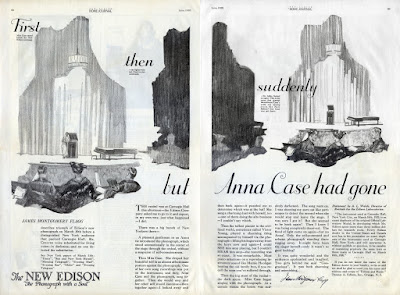We owe the idea that live performances and recordings should resemble each other to New Jersey's two most important musical and recording pioneers, Thomas Edison, and Anna Case. And here's the kicker - they set out to prove that an Edison record was as good as a live performance, but partly because of the contrivances this "proof" entailed, they wound up forever changing audiences' expectations of what live music should sound like.
 |
| Trade journal Talking Machine World, December 1914 |
It was in 1914 that Metropolitan Opera soprano and Edison recording artist Anna Case, a native of South Branch, walked into a music shop while on a concert tour in Iowa, and began to sing along with one of her own records. When she briefly paused, shop patrons were astounded that the still spinning record sounded just like the live Anna - they couldn't tell the two apart!
 |
| Full page Edison ad from 1918 featuring Anna Case. |
Edison had spent years perfecting his Diamond Disc Phonograph. The ten-inch diameter 1/4 inch thick record spinning at 80 rpm was the most technologically advanced music reproduction system of the time. But even Edison did not initially hit on the idea that his invention could be marketed as a music "re-creator", instead of merely another "talking machine".
 |
| Full page Edison ad from 1917 featuring Anna Case. |
Of course, Anna Case, Edison's favorite singer, was front and center at many tone tests and in an extensive ad campaign that lasted for the better part of the next decade. Ads that regularly featured the soprano standing next to a phonograph asked readers to come into a store and hear for themselves - and then bring the re-created Anna Case home with them. In-store and window displays featured a life-sized cut-out of Anna next to the machine.
 |
| Program for the March 10, 1920, Anna Case Tone Test concert |
 |
| Two-page ad, June 1920 |
The problem with this incredible story of invention and marketing is that it was mostly a lie. Yes, Edison's invention was probably the best of its time. And yes, it could reproduce voices very well - just not THAT well.
 |
| The program from March 10, 1920 |
Anna Case finally came clean 50 years after the Carnegie Hall show, admitting that she, and the other singers that took part in the tone tests, actually trained their voices to sound like the machine! Not only that, but even at a large venue like Carnegie Hall, the voice of an operatic soprano would certainly overwhelm the modest sound coming from the phonograph - so while the record played full volume, Anna had to turn hers down a bit.
And that's how Central New Jersey's musical pioneers set out to prove a recording was as good as a live performance by making the live performance only as good as the recording. A successful marketing experiment that has confounded musicians and listeners for almost a century!
 |
| Illustrator James Montgomery Flagg, who witnessed the Carnegie Hall tone test, sketches Anna Case after the show. |
Through the magic of YouTube, we can listen to a disc which Anna Case sang along with at the March 10. 1920 Carnegie Hall concert. Enjoy!


No comments:
Post a Comment